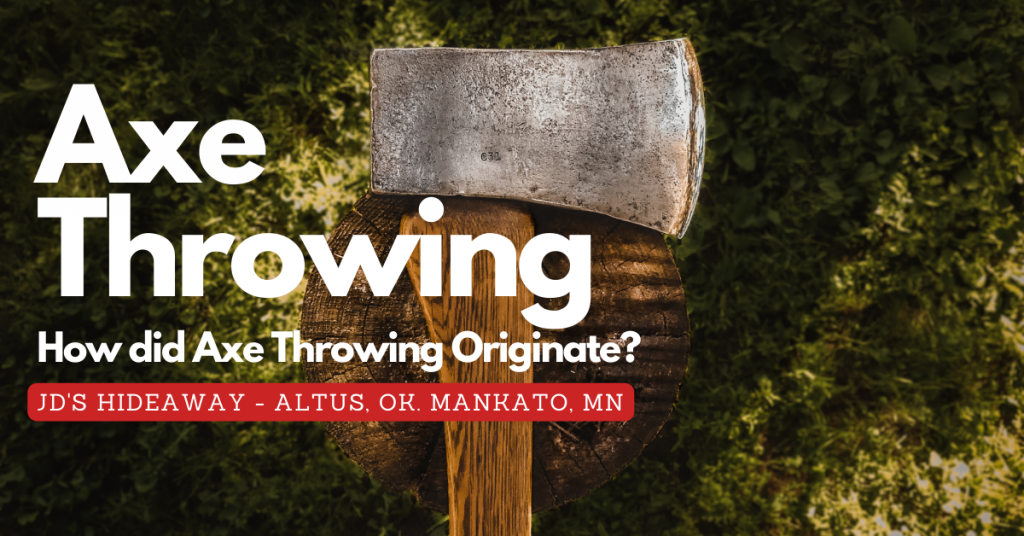
Axe throwing is a rapidly-growing alternative sport in the U.S., especially in midwest states like Oklahoma and Minnesota.
What’s the history behind axe-throwing bars? How did this unique pastime become so popular and mainstream?
In today’s post, JD’s Hideaway Axe Throwing, located in Altus, OK., and Mankato, MN., explains.
History of Axe Throwing: Weapons, Tools, and Games
Used as weapons and working tools throughout most of human history, axes have been around since the stone age – before they started attaching wooden handles to the end.
The modern throwing axe has gone through many iterations and changes to become what it is today. The axes and hatchets used at modern-day venues are safe to handle, lightweight, balanced, and easy to swing with one or two hands.
The axes of the distant past were quite the opposite; they were more difficult to wield, deadly, and aerodynamic:
- Francisca Axe – used in the middle ages by the Franks and Germanic Tribes
- Hurlbat – or “whirlbat,” an Old-English throwing axe or club used around 1327
- Tomahawk – used by Native Americans but rarely ever for throwing
Types of Modern Axes
Plastic and steel handles are the most popular for axe throwing, aside from the traditional wood handles (difficult to maintain and can slip off).
For newbies, it’s recommended to use an axe or hatchet made of fiberglass. They’re a lot easier to wield and more durable.
Historically, the most popular throwing axe was a tomahawk axe (weighing only 1.05 pounds).
But if you’re just starting out, stick to a heavier, more weighted axe. It gives you better control over your throw. When you get more experienced and hone your axe throwing technique, you can switch to a lighter axe.
The Origins of Axe Throwing Games
Loggers and lumberjacks had been around since the 1800s. But by the 1940s, American woodsmen would show off their skills (which included two-handed axe throwing) in lumberjack competitions.
These informal competitions became widely recognized as official competitions in the 1960s.
The first official axe-throwing venue started in Toronto, Canada in 2006, beginning as a quirky after-work location for friends and family to hang out, drink, and toss handheld axes at a wooden target board.
And just like disc golf (frolf), this fun pastime caught on, setting a trend and spreading like wildfire across the United States.
Why is Axe Throwing Popular?
Its popularity comes down to a few reasons:
- It’s fast paced and engaging.
- It’s affordable, with a low barrier to entry.
- It can be played solo or with as many people as you want.
The Birth of Axe Throwing Leagues
Today, axe throwing only continues to grow as an “alternative sport,” spearheaded by professional axe throwing leagues that organize formally-recognized competitions for teams.
The top two axe-throwing leagues in the nation (if not the world) include the National Axe Throwing Federation (NATF), co-founded in 2016 by Matt Wilson and Brian Simmons, and the World Axe Throwing League (WATL), founded in 2017.
There’s also a Backyard Axe Throwing League (BATL). Just like NATF, this league was founded by Mr. Wilson when he and his buddies were throwing hatchets at a softwood tree as a way to keep busy during a rainy day in Southern Ontario.
Worldwide Growth of Axe Throwing Venues
In Europe, axe-throwing venues started to spread rapidly after 2001, becoming a commercially-sponsored sport by 2016.
Today, some of the top axe-throwing venues in Europe include:
- Woodcutter: Berlin and Frankfurt, Germany.
- Axe Nation Kraków Club: Kraków, Poland (1st axe throwing club in Europe)
- Axe Throwing Europe – Sekiromet: Ljubljana, Slovenia.
Modern Axe Throwing League Facts & Game Rules
Since the sport’s humble beginnings, the rules of the game have changed quite a bit. Depending on the league, there may be different rules associated:
- NATF: goals are divided into four zones (three primaries and one additional)
- WATL: targets are divided into five zones and one additional zone
- Throwing line is 12ft from the target (minimum) to allow the axe one rotation
- IATF: only axes with hardwood handles are used, WATL allows all handle types.
- Leagues use two types of axes: small (1.3 – 1.7 lbs) and large (2.2 – 3.3 lbs) for “tiebreakers”
Universal Axe Throwing Rules:
For most professional axe-throwing games, players take 5 throws then switch sides.
If there’s a tie after 10 throws, there is a final throw from the team to break it.
For a throw to be considered legit, it has to rotate 1 time before hitting the target.
Visit our Axe Throwing Venues in Oklahoma & Minnesota
JD’s Hideaway offers a fun, upbeat atmosphere for axe-throwing games and delicious American-style fried foods.
Reserve an axe-throwing lane ahead of time or casually drop in.
You can also book our venue for birthdays, graduations, or corporate events.

